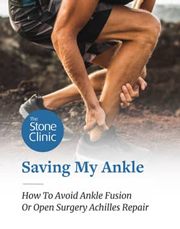High Performance Skater Bounces Back from Ankle Cartilage Injury
My life pretty much revolved around the sport. So figure skating was my first priority. I was half-day at school, half-day at the rink. And then I noticed that when I was only, I think I was 13 when I had my first surgery. And it was just a pain in my ankle just wasn't dependable anymore. It would kind of give out randomly, or I would step on it the wrong way, and there'd be a shooting pain at my ankle. And in terms of reliability, it was, it created a lot of nerve and a lot of worry around how my takeoff would be for my next jump or how the torque would be and going into spins, et cetera. So my name's Hannah Del court I was a high-performance figure skater on the way to international children's games in Russia.
When I discovered the injury that I had, which is called an osteochondral defect. So technically I have a hole in my bone, and so I continued to push through as much as I could. And then as things progressively got worse, I sought treatment in British Columbia where I'm from. Well, I definitely explored various options and I went down to Vancouver for instance, to hear what surgeons would say in Canada about what my options were. And a lot of them just involved plates and screws. And for me being 15 at the time, it that's kind of a scary thought. Fortunately, for me as a high-performance athlete, I was dealing with a chiropractor. He actually told me he had both of his ankles reconstructed by Dr. Stone, and that I needed to send an x-ray and an MRI over to him immediately
Dr. Stone: Ankle cartilage injuries are difficult problems to solve. Hannah came to us as a 16-year-old with a failed microfracture technique where she had undergone fracturing of a talar dome lesion inside of her ankle. She had a stiff, painful ankle. We looked inside, found a full thickness cartilage defect. We repaired it with our articular cartilage paste graft technique, and she's come back to us. Now, five years later, having been playing sports, returning to figure skating, and having a good functioning ankle, she returned because she knocked a small piece off inside the joint. It gave us a chance to look inside, take out the loose body and survey the ankle cartilage. She had healed it pretty well and returned to full sports. And we're proud of the fact that this cartilage repair technique was able to save an ankle joint injury in a young athlete
For the first five years after my surgery is like I had a brand new ankle I've partaken in tennis and swimming and wake surfing. And the more I get to test it out, the better, and the more confident I am at trying new things. So what happened this time around was it was great for the five years. And then just earlier this year, I'd say probably around April, it started to grind a bit. I figured that there was something that needed to be looked at. And so we had done MRIs and x-rays and sent them off to Dr. Stone because in my opinion, he's the best option I came down here and he was like, okay, hands. So this is how it's going to go. It's going to go one of two ways. And he's said to me, like directly, he's like when I open you up I'm going to do exactly what I do for myself. I will do for you. So that just gave me immediate peace of mind.
Honestly, their rehab process here as well was a huge plus for me and being an active individual myself. So it creates this synergy where you're also not really just a patient to them. They take great interest in your life and what your expectations out of the surgery are. And for me, it was just a huge win. I just want to say a huge thanks to Dr. Stone and his whole team for coming alongside me throughout my journey and, you know, being my biggest cheerleaders.
Hannah D. Profile
Arthritic ankles are often treated with screws, plates, and bone grafts—with limited success. Our patient Hannah was offered this course of treatment by a surgeon in Canada, but, understandably, did not want to suffer the loss of mobility and limitations often associated with a procedure like this.
Instead, Hannah traveled to San Francisco where Dr. Stone repaired the dead bone and cartilage in Hannah's ankle with a cartilage regeneration procedure that he personally developed: the articular cartilage paste graft. This minimally-invasive arthroscopic procedure stimulates regrowth of damaged articular cartilage surfaces without artificial components or implants, reforming durable cartilage tissue with long-term improvement in function and diminishment of pain. When applied to the ankle as part of a biologic reconstruction, we refer to this as a BioAnkle. Years later, we continue to successfully treat Hannah and help her maintain a full athletic lifestyle outdoors and on the ice.


